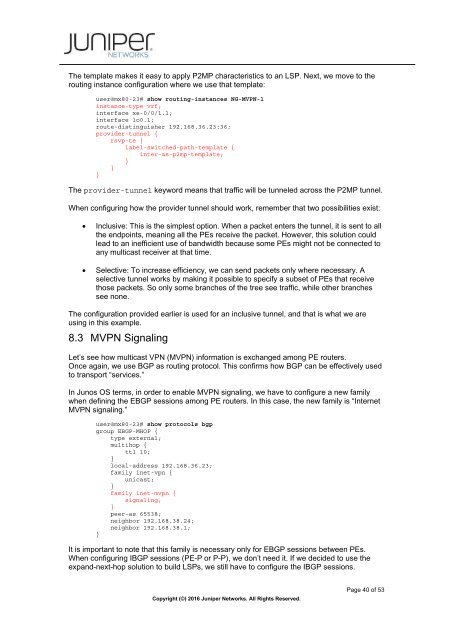2eW4ZRB
2eW4ZRB
2eW4ZRB
You also want an ePaper? Increase the reach of your titles
YUMPU automatically turns print PDFs into web optimized ePapers that Google loves.
The template makes it easy to apply P2MP characteristics to an LSP. Next, we move to the<br />
routing instance configuration where we use that template:<br />
user@mx80-23# show routing-instances NG-MVPN-1<br />
instance-type vrf;<br />
interface xe-0/0/1.1;<br />
interface lo0.1;<br />
route-distinguisher 192.168.36.23:36;<br />
provider-tunnel {<br />
rsvp-te {<br />
label-switched-path-template {<br />
inter-as-p2mp-template;<br />
}<br />
}<br />
}<br />
The provider-tunnel keyword means that traffic will be tunneled across the P2MP tunnel.<br />
When configuring how the provider tunnel should work, remember that two possibilities exist:<br />
• Inclusive: This is the simplest option. When a packet enters the tunnel, it is sent to all<br />
the endpoints, meaning all the PEs receive the packet. However, this solution could<br />
lead to an inefficient use of bandwidth because some PEs might not be connected to<br />
any multicast receiver at that time.<br />
• Selective: To increase efficiency, we can send packets only where necessary. A<br />
selective tunnel works by making it possible to specify a subset of PEs that receive<br />
those packets. So only some branches of the tree see traffic, while other branches<br />
see none.<br />
The configuration provided earlier is used for an inclusive tunnel, and that is what we are<br />
using in this example.<br />
8.3 MVPN Signaling<br />
Let’s see how multicast VPN (MVPN) information is exchanged among PE routers.<br />
Once again, we use BGP as routing protocol. This confirms how BGP can be effectively used<br />
to transport “services.”<br />
In Junos OS terms, in order to enable MVPN signaling, we have to configure a new family<br />
when defining the EBGP sessions among PE routers. In this case, the new family is “Internet<br />
MVPN signaling.”<br />
user@mx80-23# show protocols bgp<br />
group EBGP-MHOP {<br />
type external;<br />
multihop {<br />
ttl 10;<br />
}<br />
local-address 192.168.36.23;<br />
family inet-vpn {<br />
unicast;<br />
}<br />
family inet-mvpn {<br />
signaling;<br />
}<br />
peer-as 65538;<br />
neighbor 192.168.38.24;<br />
neighbor 192.168.38.1;<br />
}<br />
It is important to note that this family is necessary only for EBGP sessions between PEs.<br />
When configuring IBGP sessions (PE-P or P-P), we don’t need it. If we decided to use the<br />
expand-next-hop solution to build LSPs, we still have to configure the IBGP sessions.<br />
Copyright (©) 2016 Juniper Networks. All Rights Reserved.<br />
Page 40 of 53


